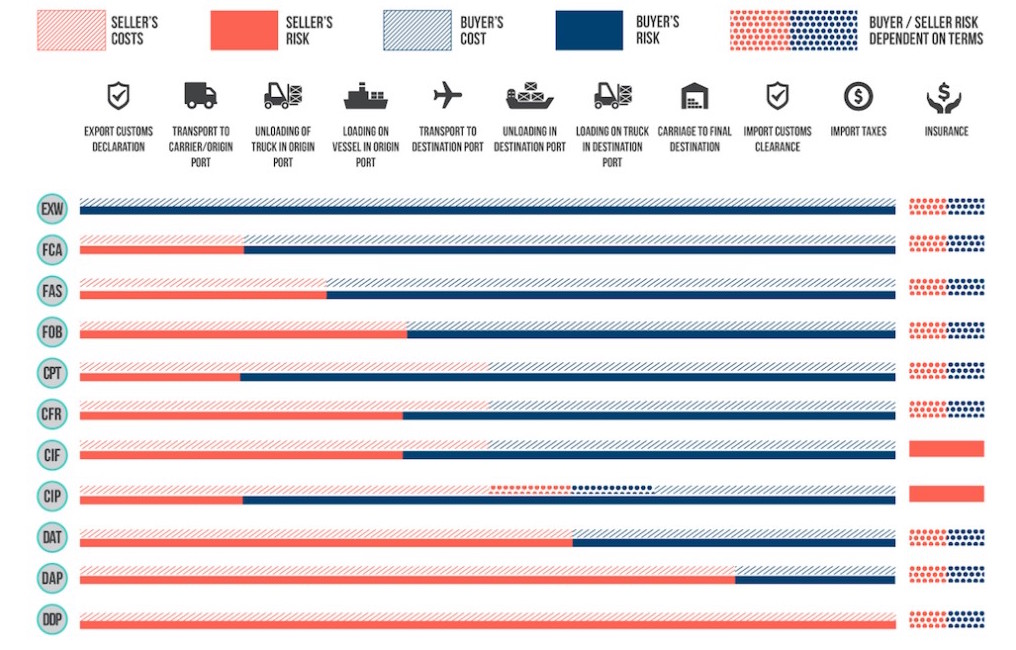Time to read: 3 min
In the global manufacturing world, logistics often prove to be the biggest hassle between a buyer and seller. Without a clear understanding of who organizes and covers what aspects of the transaction, it’s easy for responsibility to get muddy and for conflict to arise.
That’s why the International Chamber of Commerce created a list of rules to help define commercial transaction terms, now commonly known as incoterms. Incoterms, an abbreviation for International Commercial Terms, are guidelines that establish when the costs, risks, and responsibilities of a transaction transfer from seller to buyer. Incoterms primarily cover transportation and logistics costs; import and export declarations; insurance costs; and establishment of a point of delivery.
Just how important are incoterms?
“Incoterms are an indispensable part of international trade, and more so with offshore manufacturing,” says Shawn Chang, VP of Strategic Planning at Dragon Innovation. “To mitigate risks, the buyer and seller should be aware of any nuances and address those details in the contract of sale.”
What are the basics that every buyer and seller need to know before shipment begins? We’ll break down the most commonly used incoterms and what they really mean.

Commonly used incoterms and what they mean
Ex Works (EXW) – The seller makes the goods available at its location, so the buyer can take over all the transportation costs and also bears the risks of bringing the goods to their final destination.
Free Carrier (FCA) – The seller hands over the goods into the disposal of the first carrier. After the buyer takes over all the costs, the risk passes when the goods are handed over to the first carrier.
Free on Board (FOB) –The seller must load the goods on board of the ship, nominated by the buyer. Cost and risk are divided when the goods are actually on board.
Delivered Duty Paid (DDP) –The seller is responsible for delivering the goods to the named place in the country of the buyer, and pays all costs in bringing the goods to the destination.
Using incoterms
Why use one incoterm over another? It all depends on your specific operations. Say, for example, you (buyer) need a supplier in Japan (seller) to fulfill an order, and the parts need to be delivered to the United States.
If you select Ex Works (EXW), this scenario’s transaction details are pretty simple: You pay for everything. Since EXW stipulates that your supplier only is responsible for making your parts on site, you need to coordinate transportation from the supplier’s location to the port, customs clearance, and delivery to the final location.
However, if you go with Free on Board (FOB), things change before shipping. The seller is responsible for costs until the parts make it to the port of departure. Once the parts reach the port, you then take over responsibility and cover the remainder of the costs, including sea freight, customs clearance, and more.
We asked Nerijus Poskus, VP & Global Head of Ocean Freight at Flexport, about the recommended shipping incoterms when importing from China.
“Importers should consider FCA (Free Carrier) terms,” Nerijus said. “Under FCA, the exporter is responsible for delivering goods to the custody of the carrier named by the importer at an agreed delivery point; e.g., the shipper’s factory or the port of loading. That way, importing clients don’t have to deal with (and aren’t liable for) export formalities of the country from which the goods originate. The risk, responsibility for regulatory compliance, and expense is handled by the exporter. That’s especially important when importing from China, where an export license is required.”
Fictiv’s incoterms
Though China Manufacturing parts’s default incoterms are EXW, China Manufacturing parts, Inc. has an export license, and we oversee export clearance on all orders originating from China (unless requested otherwise), in order to streamline the international trade process for our customers.
No matter what you choose, it’s important to understand your working partnership with your suppliers and go with what works best for both parties.

